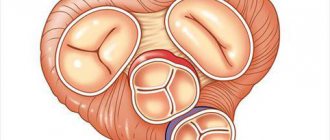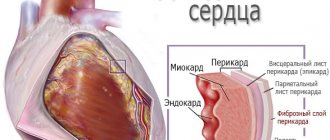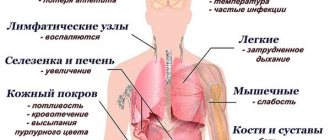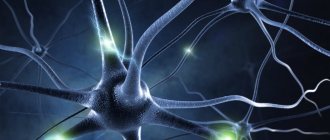Shortness of breath, or dyspnea, is a state of lack of air in a person. Although doctors call it a subjective feeling of the patient, this condition often turns out to be a manifestation of diseases of the cardiovascular system or respiratory system. In addition, shortness of breath can be caused by other health problems, such as endocrine diseases, metabolic disorders, and obesity. Sometimes shortness of breath and accompanying syndromes become the reason for placing the patient in a hospital.
What it is?
Shortness of breath, or dyspnea (breathing disorder) can be accompanied by objective respiratory disturbances (depth, frequency, rhythm) or only by subjective sensations.
According to the definition of academician B.E. Votchal, shortness of breath is primarily a patient’s sensation, forcing him to limit physical activity or increase breathing.
If breathing disorders do not cause any sensations, then this term is not used, and we can only talk about assessing the nature of the disorder, that is, breathing is labored, shallow, irregular, excessively deep, intensified. However, this does not make the suffering and psychological reaction of the patient any less real.
The definition of dyspnea proposed by the US Thoracic Society is currently accepted. According to it, shortness of breath is a reflection of the patient’s subjective perception of respiratory discomfort and includes various qualitative sensations varying in intensity. Its development can cause secondary physiological and behavioral reactions and be determined by the interaction of psychological, physiological, social and environmental factors.
Symptoms
Dyspnea is characterized by pressure in the chest, difficulty and rapid breathing. May be accompanied by pain, hemoptysis, sputum production, muscle weakness, wheezing, and neurological signs.
How to understand that shortness of breath is dangerous
Many people are interested in how to distinguish physiological dyspnea (arising from physical activity, sedentary work, etc.) from pathological shortness of breath. The following signs indicate danger:
- chest pain;
- general weakness;
- cold sweat;
- inability to take a deep breath;
- increased body temperature;
- panic attacks that occur against the background of existing symptoms;
- absence of an objective cause of dyspnea;
- an increase in the intensity of the symptom and the frequency of its occurrence.
If symptoms appear, you should consult a doctor for diagnosis
Classification
If shortness of breath occurs during physical activity, then this is normal. However, if a symptom is detected in a calm state, you should consult a doctor. To determine the possible etiology of difficulty breathing, the doctor must determine its type.
Clinicians distinguish three types of shortness of breath:
- Inspiratory. It manifests itself in difficult inhalation and is formed on the basis of a decrease in the opening in the larynx, trachea and bronchi. Characteristic of acute respiratory infections in children, diphtheria of the larynx, damage to the pleura and injuries that cause compression of the bronchi.
- Expiratory. It is detected in the patient with difficulty exhaling. The provoking factor for the development of this form of the disease is a decrease in the opening in the small bronchi. The symptom manifests itself in emphysema and chronic obstructive pulmonary disease.
- Mixed. Severe shortness of breath of a mixed type is diagnosed with advanced lung disease and heart failure.
Reasons for development
Difficulty breathing is a consequence of many diseases, including:
- respiratory pathologies: bronchial asthma, pneumonia, bronchial obstruction, pleurisy, lung cancer;
- laryngitis, laryngeal stenosis;
- diseases of the cardiovascular system: angina pectoris, heart failure;
- foreign body entering the respiratory tract;
- severe nervous shock;
- smoking;
- anemia.
All these diseases and conditions are quite dangerous to health and life.
Sometimes dyspnea can be physiological in nature and appear during intense physical activity, excess weight or pregnancy. In this case, the intensity of impaired breathing is insignificant, there are no accompanying symptoms, and the breathing itself returns to normal after a short rest.
Severity of shortness of breath
Depending on the intensity of the symptoms, shortness of breath occurs:
- 1st degree of severity - occurs when climbing stairs or uphill, as well as while running;
- 2nd degree of severity - shortness of breath causes the patient to slow down compared to the pace of a healthy person;
- Grade 3 severity – the patient is forced to constantly stop to take a breath;
- 4th degree of severity - a feeling of lack of air bothers the patient even at rest.
If breathing problems occur only during fairly intense physical exercise, then they speak of zero severity.
Cardiac dyspnea
Cardiac dyspnea is shortness of breath that develops as a consequence of heart pathologies.
As a rule, cardiac dyspnea has a chronic course. Shortness of breath in heart disease is one of the most important symptoms. In some cases, depending on the type of shortness of breath, duration, physical activity after which it appears, one can judge the stage of heart failure. It is usually characterized by inspiratory dyspnea and frequent attacks of paroxysmal (periodically recurring) nocturnal dyspnea.
The most common causes of cardiac dyspnea include:
- heart failure;
- acute coronary syndrome;
- heart defects;
- cardiomyopathy;
- myocarditis;
- pericarditis;
- hemopericardium, cardiac tamponade.
Heart failure
Heart failure is a pathology in which the heart, due to certain reasons, is unable to pump the volume of blood that is necessary for normal metabolism and the functioning of organs and systems of the body.
In most cases, heart failure develops under such pathological conditions as:
- arterial hypertension;
- IHD (coronary heart disease);
- constrictive pericarditis (inflammation of the pericardium, accompanied by its hardening and impaired heart contraction);
- restrictive cardiomyopathy (inflammation of the heart muscle with a decrease in its extensibility);
- pulmonary hypertension (increased blood pressure in the pulmonary artery);
- bradycardia (decreased heart rate) or tachycardia (increased heart rate) of various etiologies;
- heart defects.
The mechanism for the development of shortness of breath in heart failure is associated with a violation of blood ejection, which leads to insufficient nutrition of brain tissue, as well as with congestion in the lungs, when the conditions of ventilation of the lungs worsen and gas exchange is disrupted.
In the early stages of heart failure, shortness of breath may be absent. Further, as the pathology progresses, shortness of breath appears under heavy loads, under light loads, and even at rest.
Heart defects
A heart defect is a pathological change in the structures of the heart that leads to impaired blood flow. Blood flow is disrupted in both the systemic and pulmonary circulation. Heart defects can be congenital or acquired. They may concern the following structures - valves, septa, vessels, walls. Congenital heart defects appear as a result of various genetic abnormalities and intrauterine infections. Acquired heart defects can occur against the background of infective endocarditis (inflammation of the inner lining of the heart), rheumatism, and syphilis.
Heart defects include the following pathologies:
- a ventricular septal defect is an acquired heart defect, which is characterized by the presence of a defect in certain parts of the interventricular septum, which is located between the right and left ventricles of the heart;
- open oval window - a defect in the interatrial septum, which occurs due to the fact that the oval window, which participates in the blood circulation of the fetus, does not close;
- open arterial (botallian) duct, which in the prenatal period connects the aorta to the pulmonary artery, and must close during the first day of life;
- Coarctation of the aorta is a heart defect that manifests itself as a narrowing of the aortic lumen and requires cardiac surgery;
- heart valve insufficiency is a type of heart defect in which complete closure of the heart valves is impossible and reverse flow of blood occurs;
- Heart valve stenosis is characterized by narrowing or fusion of the valve leaflets and disruption of normal blood flow.
Different forms of heart disease have specific manifestations, but there are also general symptoms characteristic of the defects.
The most common symptoms of heart defects are:
- dyspnea;
- cyanosis of the skin;
- pale skin;
- loss of consciousness;
- retardation in physical development;
- headache.
Of course, knowledge of clinical manifestations alone is not enough to establish the correct diagnosis. This requires the results of instrumental studies, namely ultrasound (ultrasound) of the heart, chest X-ray, computed tomography, magnetic resonance imaging, etc.
Heart defects are diseases that can be alleviated through therapeutic methods, but can only be completely cured through surgery.
Acute coronary syndrome
Acute coronary syndrome is a group of symptoms and signs that may suggest myocardial infarction or unstable angina. Myocardial infarction is a disease that occurs as a result of an imbalance between myocardial oxygen demand and oxygen supply, which results in necrosis of an area of the myocardium. Unstable angina is considered an exacerbation of coronary heart disease, which can lead to myocardial infarction or sudden death. These two conditions are combined into one syndrome due to a common pathogenetic mechanism and the difficulty of differential diagnosis between them at first. Acute coronary syndrome occurs with atherosclerosis and thrombosis of the coronary arteries, which cannot provide the myocardium with the necessary amount of oxygen.
Symptoms of acute coronary syndrome are considered to be:
- pain behind the sternum, which can also radiate to the left shoulder, left arm, lower jaw; as a rule, the pain lasts more than 10 minutes;
- shortness of breath, feeling of lack of air;
- feeling of heaviness behind the sternum;
- paleness of the skin;
- fainting.
In order to distinguish between these two diseases (myocardial infarction and unstable angina), it is necessary to conduct an ECG (electrocardiogram), as well as a blood test for cardiac troponins. Troponins are proteins that are found in large quantities in the heart muscle and are involved in the process of muscle contraction. They are considered markers (characteristic signs) of heart disease and myocardial damage in particular.
First aid for symptoms of acute coronary syndrome is sublingual nitroglycerin (under the tongue), unfastening tight clothing that compresses the chest, providing fresh air and calling an ambulance.
Cardiomyopathy
Cardiomyopathy is a disease that is characterized by damage to the heart and is manifested by hypertrophy (increase in the volume of muscle cells of the heart) or dilatation (increase in the volume of the heart chambers).
There are two types of cardiomyopathies:
- primary (idiopathic), the cause of which is unknown, but it is assumed that these may be autoimmune disorders, infectious factors (viruses), genetic and other factors;
- secondary, which appears against the background of various diseases (hypertension, intoxication, coronary heart disease, amyloidosis and other diseases).
Clinical manifestations of cardiomyopathy, as a rule, are not pathognomonic (specific only to this disease). However, symptoms indicate the possible presence of heart disease, which is why patients often consult a doctor.
The most common manifestations of cardiomyopathy are considered to be:
- shortness of breath;
- cough;
- pale skin;
- increased fatigue;
- increased heart rate;
- dizziness.
The progressive course of cardiomyopathy can lead to a number of serious complications that threaten the patient's life. The most common complications of cardiomyopathies are myocardial infarction, heart failure, and arrhythmias.
Pericarditis
Pericarditis is an inflammatory lesion of the pericardium (the sac around the heart). The causes of pericarditis are similar to the causes of myocarditis. Pericarditis is manifested by prolonged chest pain (which, unlike acute coronary syndrome, does not go away with nitroglycerin), fever, and severe shortness of breath. With pericarditis, due to inflammatory changes in the pericardial cavity, adhesions can form, which can then grow together, which significantly complicates the functioning of the heart.
With pericarditis, shortness of breath often occurs in a horizontal position. Shortness of breath with pericarditis is a constant symptom and it does not disappear until the cause is eliminated.
Myocarditis
Myocarditis is a lesion of the myocardium (heart muscle) of a predominantly inflammatory nature. Symptoms of myocarditis are shortness of breath, chest pain, dizziness, and weakness.
Among the causes of myocarditis are:
- Bacterial and viral infections more often than other causes cause infectious myocarditis. The most common causative agents of the disease are viruses, namely the Coxsackie virus, measles virus, and rubella virus.
- Rheumatism, in which myocarditis is one of the main manifestations.
- Systemic diseases, such as systemic lupus erythematosus, vasculitis (inflammation of the walls of blood vessels) lead to myocardial damage.
- Taking certain medications (antibiotics), vaccines, and serums can also lead to myocarditis.
Myocarditis usually manifests itself as shortness of breath, fatigue, weakness, and pain in the heart area. Sometimes myocarditis can be asymptomatic. Then the disease can only be detected with the help of instrumental studies. In order to prevent the occurrence of myocarditis, it is necessary to promptly treat infectious diseases, sanitize chronic foci of infections (caries, tonsillitis), and rationally prescribe medications, vaccines and serums.
Cardiac tamponade
Cardiac tamponade is a pathological condition in which fluid accumulates in the pericardial cavity and hemodynamics (blood movement through the vessels) is disrupted. The fluid that is in the pericardial cavity compresses the heart and limits heart contractions.
Cardiac tamponade can occur both acutely (in trauma) and in chronic diseases (pericarditis). It manifests itself as painful shortness of breath, tachycardia, and decreased blood pressure. Cardiac tamponade can cause acute heart failure and shock. This pathology is very dangerous and can lead to complete cessation of cardiac activity. Therefore, timely medical intervention is of utmost importance. As an emergency, pericardial puncture and removal of pathological fluid are performed.
Symptoms
Symptoms of shortness of breath can be very different, but they are always characterized by changes and disturbances in respiratory activity. A person can breathe very quickly and shallowly, or he can take rare and very deep breaths. In both situations, he experiences an acute lack of air, a feeling of suffocation and chest compression.
With inspiratory dyspnea, it is difficult for the patient to take a breath. At the same time, he hears noise while trying to draw oxygen into his lungs. In the case of expiratory dyspnea, it is difficult to exhale, as the lumens of the bronchioles and bronchi begin to narrow.
In medical practice, there are cases of mixed dyspnea, the condition of which is the most dangerous for the body. It can lead to complete respiratory arrest and death.
Pulmonary dyspnea
Shortness of breath is a symptom of almost all diseases of the lungs and bronchi. When the respiratory tract is affected, it is associated with difficulty in the passage of air (on inhalation or exhalation). In lung diseases, shortness of breath occurs because oxygen cannot penetrate normally through the walls of the alveoli into the bloodstream.
Chronic obstructive pulmonary disease (COPD)
COPD is a broad term that is sometimes confused with chronic bronchitis, but in fact they are not exactly the same thing. Chronic obstructive pulmonary diseases are an independent group of diseases that are accompanied by a narrowing of the lumen of the bronchi, and manifest themselves in the form of shortness of breath as the main symptom.
Constant shortness of breath in COPD occurs due to a narrowing of the airways, which is caused by the action of irritating harmful substances on them. Most often, the disease occurs in heavy smokers and people who are employed in hazardous work.
Chronic obstructive pulmonary diseases are characterized by the following features:
- The process of narrowing of the bronchi is practically irreversible: it can be stopped and compensated with the help of medications, but cannot be reversed.
- The narrowing of the airways and, as a result, shortness of breath are constantly increasing.
- Dyspnea is predominantly expiratory in nature: small bronchi and bronchioles are affected. Therefore, the patient inhales air easily, but exhales it with difficulty.
- Shortness of breath in such patients is combined with a wet cough, during which sputum is expelled.
If shortness of breath is chronic and there is a suspicion of COPD, then the therapist or pulmonologist prescribes the patient an examination, which includes spirography (assessment of the respiratory function of the lungs), chest X-ray in frontal and lateral projections, and sputum examination.
Treatment of shortness of breath in COPD is complex and lengthy. The disease often leads to the patient's disability and loss of ability to work.
Bronchitis
Shortness of breath is a characteristic symptom of bronchitis, an inflammatory infection of the bronchi. Inflammation can be localized in the large bronchus, in smaller ones, and in bronchioles, which directly pass into the lung tissue (the disease is called bronchiolitis).
Dyspnea occurs in acute and chronic obstructive bronchitis. The course and symptoms of these forms of the disease differ:
- Acute bronchitis has all the signs of an acute infectious disease. The patient's body temperature rises, a runny nose, sore throat, dry or wet cough, and a disturbance in general condition occur. Treatment of shortness of breath during bronchitis involves the prescription of antiviral and antibacterial drugs, expectorants, and bronchodilators (dilating the lumen of the bronchi).
- Chronic bronchitis can lead to constant shortness of breath, or episodes of shortness of breath in the form of exacerbations. This disease is not always caused by infections: it is caused by long-term irritation of the bronchial tree with various allergens and harmful chemicals, tobacco smoke. Treatment for chronic bronchitis is usually long-term.
With obstructive bronchitis, difficulty in exhaling (expiratory shortness of breath) is most often noted. This is caused by three groups of reasons, which the doctor tries to combat during treatment:
- secretion of a large amount of viscous mucus: expectorants help remove it;
- an inflammatory reaction, as a result of which the wall of the bronchus swells, narrowing its lumen: this condition is combated with the help of anti-inflammatory,
- antiviral and antimicrobial drugs;
- spasm of the muscles that make up the bronchial wall: against this condition, the doctor prescribes bronchodilators and antiallergic drugs.
Pneumonia
Pneumonia is an infectious disease in which an inflammatory process develops in the lung tissue. Shortness of breath and other symptoms occur, the severity of which depends on the pathogen, the extent of the lesion, and the involvement of one or both lungs in the process.
Shortness of breath with pneumonia is combined with other symptoms:
- Usually the disease begins with a sharp increase in temperature. It is similar to a severe respiratory viral infection. The patient feels a deterioration in his general condition.
- There is a severe cough, which leads to the release of a large amount of pus.
- Shortness of breath with pneumonia is observed from the very beginning of the disease and is of a mixed nature, that is, the patient has difficulty inhaling and exhaling.
- Pale, sometimes bluish-gray skin tone.
- Pain in the chest, especially in the place where the pathological focus is located.
- In severe cases, pneumonia is often complicated by heart failure, which leads to increased shortness of breath and the appearance of other characteristic symptoms.
If you experience severe shortness of breath, cough or other symptoms of pneumonia, you should consult a doctor as soon as possible. If treatment is not started within the first 8 hours, the prognosis for the patient is greatly worsened, up to the possibility of death. The main diagnostic method for shortness of breath caused by pneumonia is chest x-ray. Antibacterial and other medications are prescribed.
Lung tumor
Lung cancer is a malignant tumor that is asymptomatic in the early stages. At the very beginning, the process can only be detected by chance, during radiography or fluorography. Later, when the malignant neoplasm reaches a sufficiently large size, shortness of breath and other symptoms occur:
- Frequent hacking cough that bothers the patient almost constantly. In this case, sputum is released in very small quantities.
- Hemoptysis is one of the most characteristic symptoms of lung cancer and tuberculosis.
- Chest pain is associated with shortness of breath and other symptoms if the tumor grows beyond the lungs and affects the chest wall.
- Violation of the general condition of the patient, weakness, lethargy, loss of body weight and complete exhaustion.
- Lung tumors often metastasize to the lymph nodes, nerves, internal organs, ribs, sternum, and spinal column. In this case, additional symptoms and complaints appear.
Diagnosis of the causes of shortness of breath in malignant tumors in the early stages is quite difficult. The most informative methods are radiography, computed tomography, examination of tumor markers in the blood (special substances that are formed in the body in the presence of a tumor), cytological examination of sputum, and bronchoscopy.
Treatment may include surgery, the use of cytostatics, radiation therapy and other, more modern methods.
Asthma
Bronchial asthma is an allergic disease in which there is an inflammatory process in the bronchi, accompanied by spasm of their walls and the development of shortness of breath. The following symptoms are characteristic of this pathology:
- Dyspnea in bronchial asthma always develops in the form of attacks. In this case, it is easy for the patient to inhale air, but it is very difficult to exhale it (expiratory dyspnea). The attack usually goes away after taking or inhaling bronchomimetics - drugs that help relax the bronchial wall and expand its lumen.
- With a prolonged attack of shortness of breath, pain occurs in the lower part of the chest, which is associated with tension in the diaphragm.
- During an attack, a cough and a feeling of some congestion in the chest occur. In this case, practically no sputum is produced. It is viscous, glassy, and comes off in small quantities, usually at the end of an episode of suffocation.
- Shortness of breath and other symptoms of bronchial asthma most often occur during patient contact with certain allergens: plant pollen, animal hair, dust, etc.
- Often, other allergic reactions such as urticaria, rash, allergic rhinitis, etc. are also observed simultaneously.
- The most severe manifestation of bronchial asthma is the so-called status asthmaticus. It develops like a normal attack, but is not controlled with bronchomimetics. Gradually, the patient's condition worsens, to the point that he falls into a coma. Status asthmaticus is a life-threatening condition and requires emergency medical attention.
Other pulmonary diseases
There are also a large number of pulmonary pathologies that are less common, but can also lead to shortness of breath:
- Disruption of the inhalation process as a result of damage to the respiratory muscles (intercostal muscles and diaphragm) with poliomyelitis, myasthenia gravis, and paralysis.
- Disturbance in the shape of the chest and compression of the lungs due to scoliosis, defects of the thoracic vertebrae, ankylosing spondylitis, etc.
- Pulmonary tuberculosis is a specific infectious disease caused by Mycobacterium tuberculosis.
- Pulmonary actinomycosis is a fungal disease caused primarily by a significant decrease in immunity.
- Pneumothorax is a condition in which the lung tissue is damaged and air leaks from the lungs into the chest cavity. The most common spontaneous pneumothorax is caused by infections and chronic processes in the lungs.
- Emphysema is swelling of the lung tissue that also occurs in some chronic diseases.
- Silicosis is an occupational disease that is associated with deposits of dust particles in the lungs, and manifests itself in the form of shortness of breath and other symptoms.
- Sarcoidosis is an infectious disease of the lungs.
Breathing disorders in the elderly
With age, all internal organs and tissues age irreversibly, which leads to long-term chronic diseases. Also, in an elderly person, the body’s natural defenses against viruses, fungi and bacteria are reduced. The result is vulnerability to severe lung infections. Taking into account all these nuances, we can say that after 60 years, breathing disorder can be caused by a large number of different diseases characteristic of other ages:
- Anemia;
- Pneumonia;
- COPD;
- Persistent changes in the bronchi, with a long course of bronchial asthma.
However, the listed pathologies fade into the background in older people. Significantly more often they experience shortness of breath due to heart failure. A common cause of difficulty in inhaling/exhaling is cancer of the bronchi or lung tissue.
see a new study by scientists on the effects of stress on the heart.
Heart failure
Most heart diseases develop due to a lack of blood supply. Over time, “starvation” of tissues inevitably leads to weakening of muscles, decreased tone and persistent dysfunction of the organ. As a result, blood begins to move slowly throughout the body, and in the most distant parts or some organs it may even stagnate. This condition is called “heart failure”.
Respiratory disorders occur when blood stagnates in the lungs and its liquid part sweats through the walls of blood vessels. As a result, edema forms, which interferes with the normal exchange of oxygen and carbon dioxide. It is the main cause of cardiac dyspnea. It has the following features:
- It is usually more difficult for the patient to inhale than to exhale;
- Intensification of the symptom occurs after physical stress or in the “lying” position;
- Respiratory disturbance is not accompanied by fever, increased sweating, apathy and other signs of intoxication;
- You can often find other typical symptoms of heart failure - swelling in the legs/arms, pale skin, episodes of dizziness.
Treatment of shortness of breath caused by cardiac dysfunction is quite complex. To relieve this symptom once, it is enough to remove excess fluid from the lungs and stimulate the heart. However, it is almost impossible to completely get rid of this pathology. The patient requires ongoing therapy to slow the progression of the disease.
Malignant tumors
Lung cancer is the most common cancer in the Russian Federation, and it mainly affects men over 60 years of age. This is due to a large number of factors affecting their body, the most important of which are tobacco, occupational hazards and frequent bronchitis.
A malignant tumor of the bronchus/lungs is a deadly disease in which cells begin to divide uncontrollably and interfere with normal breathing. Cancer can grow to a significant size and completely close the lumen of the central bronchus, which will lead to “switching off” the entire lung. In addition, the tumor can “weed out” throughout the body and damage almost all internal organs.
Recognizing this disease can be extremely difficult. For a long time it does not manifest itself in any way - symptoms appear only when the cancer is of a significant size. The first warning signs of pathology are as follows:
- The appearance of hemoptysis, against the background of complete health;
- Persistent fever (several months) up to 37.5-38oC;
- A sharp decrease in body weight, without a special diet or active exercise (more than 3 kg per month);
- Constant fatigue, “weakness”, feeling of malaise.
Severe breathing disorders occur after a long course of the disease. If it is combined with the listed symptoms, this is a reason to specifically look for cancer.
Shortness of breath with anemia
Anemia is a group of diseases characterized by changes in the composition of the blood, namely a decrease in the content of hemoglobin and red blood cells. Since the transport of oxygen from the lungs directly to the organs and tissues is carried out precisely with the help of hemoglobin, when its amount decreases, the body begins to experience oxygen starvation - hypoxia. Of course, he tries to compensate for this condition, roughly speaking, to pump more oxygen into the blood, as a result of which the frequency and depth of breaths increases, i.e. shortness of breath occurs. There are different types of anemia and they arise due to different reasons:
- for congenital metabolic disorders;
- as a symptom of cancer, in particular blood cancer;
- insufficient intake of iron from food (for vegetarians, for example);
- chronic bleeding (with peptic ulcer, uterine leiomyoma);
- after recent severe infectious or somatic diseases.
In addition to shortness of breath with anemia, the patient complains of:
- severe weakness, loss of strength;
- decreased quality of sleep, decreased appetite;
- dizziness, headaches, decreased performance, impaired concentration and memory.
Persons suffering from anemia are distinguished by pale skin, and in some types of the disease - by a yellow tint, or jaundice.
Diagnosing anemia is easy - just take a general blood test. If there are changes in it that indicate anemia, a series of examinations, both laboratory and instrumental, will be prescribed to clarify the diagnosis and identify the causes of the disease. Treatment is prescribed by a hematologist.
Shortness of breath due to nervous disorders
Up to 75% of patients of psychiatrists and neurologists complain from time to time of more or less severe shortness of breath.
Such patients are disturbed by a feeling of lack of air, which is often accompanied by the fear of death from suffocation. Patients with psychogenic dyspnea are mostly suspicious people with an unstable psyche and a tendency toward hypochondria. Shortness of breath can develop in them under stress or even for no apparent reason. In some cases, the so-called attacks of false asthma.
A specific feature of shortness of breath in neurotic conditions is its “noise production” by the patient. He breathes loudly and frequently, moans and groans, trying to attract attention.
Diseases of the heart and blood vessels that cause shortness of breath
The root cause of dyspnea in patients with cardiovascular pathologies is a state of increased pressure in the vessels that supply the heart muscle. As the disease develops, shortness of breath increases, from the first to the fourth degree, when the disorder is observed even when breathing at rest.
Severe forms of heart damage give rise to paroxysmal nocturnal dyspnea, that is, the patient suddenly develops attacks of breathlessness at night during sleep. The disease is called cardiac asthma; against its background, fluid stagnation appears in the lungs. Sharp pain may be present in the chest, the patient may experience increased heart rate, distant wheezing, and gurgling in the lungs.
Dyspnea due to endocrine diseases
Often, breathing problems are an indirect symptom of thyroid dysfunction. With thyrotoxicosis - increased levels of thyroid hormones - metabolism accelerates, as a result of which all tissues and organs require more oxygen than before. The heart may not be able to cope with the increased load, resulting in compensatory shortness of breath.
Insufficiency of thyroid hormones, among other diseases, can cause excess weight. Fat deposition on internal organs, including the heart, can have an extremely negative impact on its functions.
Shortness of breath may also indicate that the patient has diabetes mellitus, in which vascular pathologies are common. The body tries to compensate for the lack of nutrition of organs and tissues, including their supply of oxygen, with the help of forced breathing. Developing diabetic nephropathy only worsens the situation, filling the blood with toxic metabolites.
Shortness of breath in pregnant women
During pregnancy, the total volume of circulating blood increases.
A woman’s respiratory system must supply oxygen to two organisms at once - the expectant mother and the developing fetus. Since the uterus increases significantly in size, it puts pressure on the diaphragm, somewhat reducing the respiratory excursion. These changes cause shortness of breath in many pregnant women. The respiratory rate increases to 22-24 breaths per minute and further increases with emotional or physical stress.
Dyspnea may progress as the fetus grows; in addition, it is aggravated by anemia, which is often observed in expectant mothers. If the respiratory rate exceeds the above values, this is a reason to be extremely wary and consult with the antenatal clinic doctor who is managing the pregnancy.
Shortness of breath in children
Most often, shortness of breath in children occurs under the following pathological conditions:
- Viral and bacterial bronchitis, pneumonia, bronchial asthma, allergies;
- Acute stenosing laryngotracheitis, or false croup (a feature of the structure of the larynx in children is its small lumen, which, with inflammatory changes in the mucous membrane of this organ, can lead to disruption of the passage of air through it; usually false croup develops at night - swelling increases in the area of the vocal cords, leading to severe inspiratory shortness of breath and suffocation; in this condition, it is necessary to provide the child with a flow of fresh air and immediately call an ambulance);
- Respiratory distress syndrome of the newborn (often recorded in premature babies whose mothers suffer from diabetes mellitus, cardiovascular disorders, diseases of the genital area; intrauterine hypoxia, asphyxia contribute to it; clinically manifested by shortness of breath with respiratory rate over 60 per minute, a blue tint of the skin and their pallor, chest rigidity is also noted; treatment must begin as early as possible - the most modern method is the introduction of pulmonary surfactant into the trachea of the newborn in the first minutes of his life);
- Congenital heart defects (due to intrauterine development disorders, the child develops pathological communications between the great vessels or cavities of the heart, leading to mixing of venous and arterial blood; as a result, the organs and tissues of the body receive blood that is not saturated with oxygen and experience hypoxia; depending on the severity dynamic observation and/or surgical treatment is indicated).
Diagnostics
Since there are a large number of diseases that cause shortness of breath, and their manifestations are often similar, the doctor may need additional tests to determine the disease. Depending on his assumptions, he may prescribe the following diagnostic measures:
| Study | Norm | Changes in pathologies |
Laboratory | ||
| Complete blood count (abbreviated as CBC) | Red blood cells (RBC)
Hemoglobin (Hb)
Leukocytes (WBC) 4-9*109/l. Eosinophils (EO) – up to 5% of all leukocytes or no more than 0.3*109/l. ESR – less than 15 mm/hour. | Anemia
Pneumonia
Bronchial asthma
RS infection
|
| Biochemical blood test | C-reactive protein (CRP) – no more than 5 mg/l. | Pneumonia, RS infection
|
| Sputum examination |
| Pneumonia
Bronchial asthma
|
Instrumental | ||
| ECG | Correct sinus rhythm with heart rate 60-90 beats/min. | Heart failure
|
| X-ray/fluorography of the lungs | No changes. | This test can reliably confirm the presence of pneumonia and suggest the presence of lung cancer. |
| Spirometry with bronchodilator test |
| COPD
Bronchial asthma
|
| CT scan | No pathological changes. | This study is the “gold standard” for diagnosing lung cancer. |
Depending on the research results, the doctor determines the cause of respiratory disorders and prescribes special treatment. It differs significantly in various pathologies, so the disease should be accurately diagnosed before therapy.
What to do and how to treat?
As we found out, the method of getting rid of shortness of breath depends entirely on its cause. Each of the diseases that can cause difficulty breathing requires an individual approach, passing certain tests and undergoing various examinations. If you feel that, in addition to shortness of breath, something else is bothering you, then therapy should be prescribed by a doctor and only a doctor - no need to self-medicate! If an attack of shortness of breath takes you by surprise, you should stop any physical activity. If the condition lasts more than 10 minutes, you must call an ambulance.
There are general guidelines for preventing shortness of breath that anyone can follow.
- Spend more time in the fresh air and, if possible, avoid walking near busy highways.
- If you lead a sedentary lifestyle, try to change this - at a minimum, you should spend 20 minutes a day walking briskly. You can go swimming - one of the most health-improving sports.
- Try to form the right diet and give up tobacco products - overeating, like smoking, contributes to breathing problems.
- Pay attention to breathing exercises - it will help improve your health and prevent shortness of breath.
- If you are allergic, you should avoid contact with allergens (dust, animal hair, pollen), as they cause bronchospasm. A breather will help prevent the listed allergens from entering your home. And those who suffer from food allergies should adhere to an individual diet.
Traditional methods
Traditional medicine has accumulated considerable experience in eliminating shortness of breath through the use of medicinal plants. Here are some useful tips:
- Drinking a decoction of coltsfoot relieves shortness of breath with difficulty breathing.
- Using wild rosemary decoction is an excellent remedy for shortness of breath.
- An infusion of birch leaves normalizes breathing in heart failure.
- To eliminate shortness of breath, you can prepare an elixir that has a healing effect. Combine 250 g of chopped garlic and the juice of 20 lemons. Pour the mixture into a dark glass container and keep in the dark for 10 days. Take the resulting drug 1 tsp. before meals three times a day. It is recommended to drink it with plenty of water.
You should not rely only on traditional methods of treating shortness of breath, since, while masking negative symptoms, they do not treat the disease that is their root cause.










